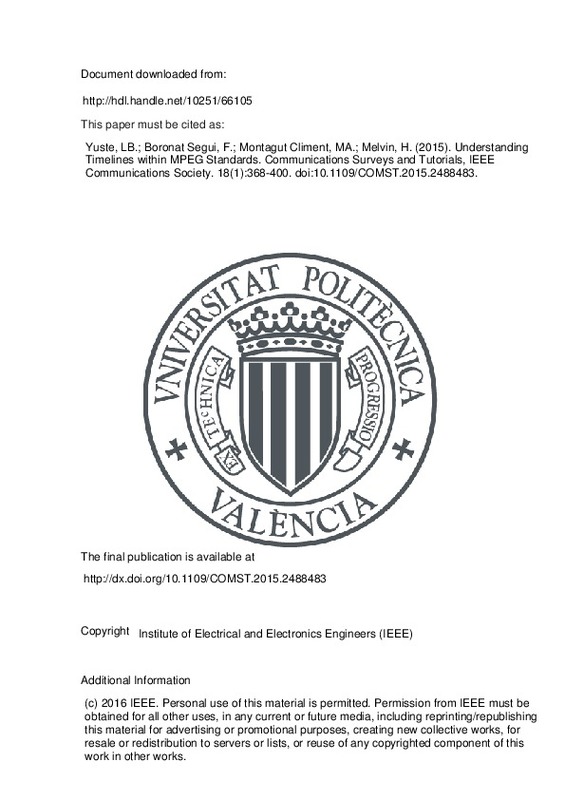JavaScript is disabled for your browser. Some features of this site may not work without it.
Buscar en RiuNet
Listar
Mi cuenta
Estadísticas
Ayuda RiuNet
Admin. UPV
Understanding Timelines within MPEG Standards
Mostrar el registro sencillo del ítem
Ficheros en el ítem
| dc.contributor.author | Yuste, Lourdes Beloqui
|
es_ES |
| dc.contributor.author | Boronat Segui, Fernando
|
es_ES |
| dc.contributor.author | Montagut Climent, Mario Alberto
|
es_ES |
| dc.contributor.author | Melvin, Hugh
|
es_ES |
| dc.date.accessioned | 2016-06-17T15:19:42Z | |
| dc.date.available | 2016-06-17T15:19:42Z | |
| dc.date.issued | 2015-10-07 | |
| dc.identifier.issn | 1553-877X | |
| dc.identifier.uri | http://hdl.handle.net/10251/66105 | |
| dc.description | (c) 2016 IEEE. Personal use of this material is permitted. Permission from IEEE must be obtained for all other uses, in any current or future media, including reprinting/republishing this material for advertising or promotional purposes, creating new collective works, for resale or redistribution to servers or lists, or reuse of any copyrighted component of this work in other works. | es_ES |
| dc.description.abstract | Nowadays, media content can be delivered via diverse broadband and broadcast technologies. Although these different technologies have somehow become rivals, their coordinated usage and convergence, by leveraging of their strengths and complementary characteristics, can bring many benefits to both operators and customers. For example, broadcast TV content can be augmented by on-demand broadband media content to provide enriched and personalized services, such as multi-view TV, audio language selection, and inclusion of real-time web feeds. A piece of evidence is the recent Hybrid Broadcast Broadband TV (HbbTV) standard, which aims at harmonizing the delivery and consumption of (hybrid) broadcast and broadband TV content. A key challenge in these emerging scenarios is the synchronization between the involved media streams, which can be originated by the same or different sources, and delivered via the same or different technologies. To enable synchronized (hybrid) media delivery services, some mechanisms providing timelines at the source side are necessary to accurately time align the involved media streams at the receiver-side. This paper provides a comprehensive review of how clock references (timing) and timestamps (time) are conveyed and interpreted when using the most widespread delivery technologies, such as DVB, RTP/RTCP and MPEG standards (e.g., MPEG-2, MPEG-4, MPEG-DASH, and MMT). It is particularly focused on the format, resolution, frequency, and the position within the bitstream of the fields conveying timing information, as well as on the involved components and packetization aspects. Finally, it provides a survey of proofs of concepts making use of these synchronization related mechanisms. This complete and thorough source of information can be very useful for scholars and practitioners interested in media services with synchronization demands. | es_ES |
| dc.description.sponsorship | This work has been funded, partially, by the "Fondo Europeo de Desarrollo Regional" (FEDER) and the Spanish Ministry of Economy and Competitiveness, under its R&D&i Support Program in project with ref TEC2013-45492-R. | en_EN |
| dc.language | Inglés | es_ES |
| dc.publisher | Institute of Electrical and Electronics Engineers (IEEE) | es_ES |
| dc.relation.ispartof | Communications Surveys and Tutorials, IEEE Communications Society | es_ES |
| dc.rights | Reserva de todos los derechos | es_ES |
| dc.subject | Media synchronization | es_ES |
| dc.subject | Timelines (clock references and timestamps) | es_ES |
| dc.subject | MPEG | es_ES |
| dc.subject | ISO BMFF | es_ES |
| dc.subject | MPEG-DASH | es_ES |
| dc.subject | MMT | es_ES |
| dc.subject | RTP | es_ES |
| dc.subject | RTCP | es_ES |
| dc.subject.classification | INGENIERIA TELEMATICA | es_ES |
| dc.title | Understanding Timelines within MPEG Standards | es_ES |
| dc.type | Artículo | es_ES |
| dc.identifier.doi | 10.1109/COMST.2015.2488483 | |
| dc.relation.projectID | info:eu-repo/grantAgreement/MINECO//TEC2013-45492-R/ES/SINCRONIZACION HIBRIDA E INTER-DESTINATARIO (IDMS) PARA POSIBILITAR EXPERIENCIAS MULTIMEDIA ENRIQUECIDAS, PERSONALIZADAS, INMERSIVAS Y COMPARTIDAS/ | es_ES |
| dc.rights.accessRights | Abierto | es_ES |
| dc.contributor.affiliation | Universitat Politècnica de València. Departamento de Comunicaciones - Departament de Comunicacions | es_ES |
| dc.description.bibliographicCitation | Yuste, LB.; Boronat Segui, F.; Montagut Climent, MA.; Melvin, H. (2015). Understanding Timelines within MPEG Standards. Communications Surveys and Tutorials, IEEE Communications Society. 18(1):368-400. https://doi.org/10.1109/COMST.2015.2488483 | es_ES |
| dc.description.accrualMethod | S | es_ES |
| dc.relation.publisherversion | http://dx.doi.org/10.1109/COMST.2015.2488483 | es_ES |
| dc.description.upvformatpinicio | 368 | es_ES |
| dc.description.upvformatpfin | 400 | es_ES |
| dc.type.version | info:eu-repo/semantics/publishedVersion | es_ES |
| dc.description.volume | 18 | es_ES |
| dc.description.issue | 1 | es_ES |
| dc.relation.senia | 302320 | es_ES |
| dc.contributor.funder | Ministerio de Economía y Competitividad | es_ES |
| dc.contributor.funder | European Regional Development Fund | es_ES |







![[Cerrado]](/themes/UPV/images/candado.png)

